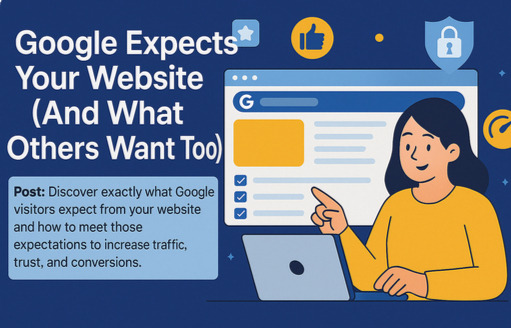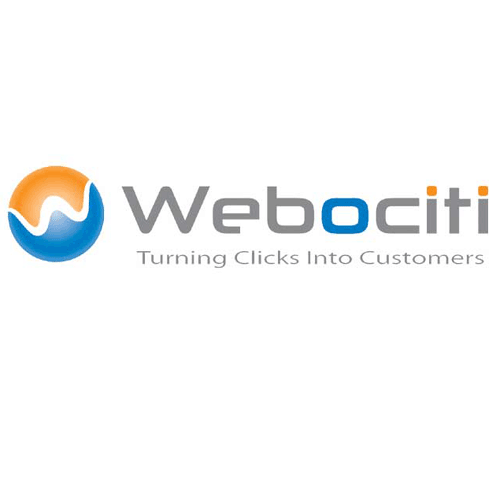
21 Apr What Google (and Your Customers) Expect From Your Website in 2025
What Google Expects From Your Website in 2025 (And What Customers Want Too)
What Google Expects From Your Website: A 2025 Wake-Up Call
If your website isn’t generating leads, building trust, or delivering a great user experience, it’s falling behind. As we head into 2025, both Google and your potential customers expect more than just a pretty homepage. They want speed, clarity, security, and usefulness—all from the first click. In this post, we’ll break down what Google expects from your website and how to exceed those expectations.
Why What Google Expects From Your Website Matters
Google remains the gatekeeper to online visibility. Its ranking algorithm grows more sophisticated each year, increasingly focused on user experience and content quality. In 2025, Google’s  expectations will include:
expectations will include:
- Core Web Vitals: Measuring page load speed, interactivity, and visual stability
- Mobile-first indexing: Prioritizing mobile usability and responsive design
- Helpful content: Rewarding content that genuinely solves problems and demonstrates expertise
- AI-generated content detection: Ensuring your website adds human value beyond automation
- EEAT: Experience, Expertise, Authoritativeness, and Trustworthiness—Google’s trust metrics for ranking
For a deeper look at these priorities, check out Google’s Page Experience guidelines.
What Customers Expect From Your Website in 2025
It’s not just Google’s bots evaluating your site—your visitors are, too. In 2025, your customers expect your website to deliver fast, helpful, and secure experiences. That means your site must:
- Load fast: 2 seconds or less is the new standard
- Be mobile-optimized: More than 70% of browsing is now on smartphones
- Provide instant clarity: Who you are, what you offer, and how it helps them—within 5 seconds
- Offer social proof: Testimonials, reviews, and case studies
- Feel personal: Content and calls to action tailored to their intent
- Be secure and trustworthy: SSL encryption, transparent policies, and fast support
Today’s online audiences have shorter attention spans and higher expectations. A poorly optimized site isn’t just an inconvenience—it’s a dealbreaker. Your website is often the first impression of your business, and visitors will judge your professionalism, credibility, and capability based on it within seconds. Meeting these expectations isn’t a luxury—it’s a necessity for competing online.
1. Core Web Vitals: What Google Expects From Your Website Speed
Google’s Core Web Vitals will continue to shape rankings. These metrics include:
- Largest Contentful Paint (LCP): How fast the main content loads
- First Input Delay (FID): How quickly users can interact
- Cumulative Layout Shift (CLS): How stable the page layout is while loading
If your site takes more than 2.5 seconds to load or jumps around as it loads, you’re likely losing both rankings and visitors. Optimizing images, enabling caching, and reducing unnecessary code are crucial.
Simple updates like choosing faster hosting, compressing files, or using a content delivery network (CDN) can significantly improve your scores and enhance both SEO and UX. Test your site regularly with tools like Google PageSpeed Insights or GTmetrix to ensure optimal performance.
2. Mobile Optimization: Critical to What Google Expects From Your Website
With Google using mobile-first indexing, your mobile site is now your primary site. That means navigation, tap targets, image loading, and copy readability must all be optimized for smaller screens. In 2025, visitors will leave quickly if your mobile experience feels cramped, confusing, or slow.
Focus on mobile menus that are easy to access, avoid intrusive pop-ups, and make sure buttons are easy to click with a thumb. Clean, simple designs and mobile-first layouts ensure you won’t alienate over half your audience.
3. Content That Actually Helps (and Meets Google’s Expectations)
Google’s Helpful Content Update puts the user first. Gone are the days of keyword stuffing or shallow blog posts. Your content must answer real questions and show real expertise. Blogs, FAQs, landing pages, and even product pages should be written with clarity and helpful intent.
Use structured data, include FAQs, add video summaries, and link to authoritative sources like Google’s SEO Starter Guide and Moz’s Beginner’s Guide to SEO. Keep content skimmable, but detailed.
Also consider using long-form blog content that answers related questions in depth. This not only satisfies your audience but improves dwell time and signals quality to search engines.
4. EEAT: What Google Expects From Your Website’s Trust Signals
Google is pushing hard on “EEAT” (Experience, Expertise, Authoritativeness, and Trustworthiness). To compete, your site should:
- Feature expert authors or real company leadership
- Include detailed “About” and “Team” pages
- Display client logos, case studies, and testimonials
- Link out to credible sources
- Maintain an active blog that demonstrates thought leadership
These trust signals assure both Google and your visitors that your brand is knowledgeable, legitimate, and worth doing business with. The more transparent and informative you are, the more likely people are to engage and convert.
🚀 Let’s Improve Your Website Today
5. Human Over AI: Why Originality Matters More Than Ever
As AI content becomes more common, Google is prioritizing human insight and experience. Repurposing generic content will lower your visibility. Use storytelling, personal examples, and real case studies to stand out. Voice and tone that reflects your brand’s personality are also key.
Think of content as a conversation. Speak directly to your audience’s problems, and don’t be afraid to inject personality. In 2025, people won’t just be searching for information—they’ll be seeking connection and credibility.
6. Design That Supports What Google and Customers Expect
Good design isn’t about bells and whistles. It’s about guiding visitors toward action. In 2025, effective website design will:
- Use a clear visual hierarchy and whitespace
- Feature short headlines and action-oriented CTAs
- Balance images with copy (and use real photography when possible)
- Keep forms short and user-friendly
Your website is your #1 sales rep. Make sure it looks and behaves like one. If users get lost, overwhelmed, or distracted—they won’t convert. Simplicity is more effective than complexity when your goal is action.
7. Conversion-Ready: What Google Expects From Your Website’s Engagement
Traffic means nothing without conversion. Your website should be optimized to capture leads, guide inquiries, and support sales follow-up. Essentials include:
- Sticky call-to-action buttons
- Live chat or contact widgets
- Lead magnets (eBooks, free consultations)
- Exit-intent popups or reminders
In 2025, people expect to interact on their terms. Give them multiple ways to raise their hand. And make your conversion actions feel seamless and rewarding, not like a sales trap.
Key Takeaways: How to Future-Proof Your Website
- Meet Core Web Vitals benchmarks: fast, stable, and interactive
- Design mobile-first with intuitive navigation
- Create human-first content with real value
- Showcase trust signals: reviews, credentials, partnerships
- Optimize for conversions: clear CTAs and interactive elements
Is Your Website Ready for What Google Expects in 2025?
Chances are, your website could be doing more to meet what Google expects from your website and your customers’ expectations. At Webociti, we help businesses transform outdated websites into modern growth engines that rank better, convert more, and build trust with every click.
📞 Schedule Your Free Website Review


